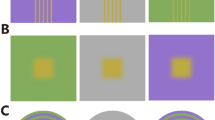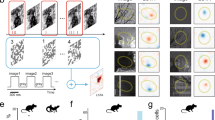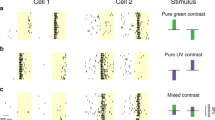Abstract
Observation of human subjects shows that the spectral returns of equiluminant colored surrounds govern the apparent brightness of achromatic test targets. The influence of color on brightness provides further evidence that perceptions of luminance are generated according to the empirical frequency of the possible sources of visual stimuli, and suggests a novel way of understanding color contrast and constancy.
This is a preview of subscription content, access via your institution
Access options
Subscribe to this journal
Receive 12 print issues and online access
$209.00 per year
only $17.42 per issue
Buy this article
- Purchase on Springer Link
- Instant access to full article PDF
Prices may be subject to local taxes which are calculated during checkout





Similar content being viewed by others
References
Adelson, E. H. in The Cognitive Neurosciences 2nd edn. (MIT Press, Cambridge, Massachusetts, in press).
Wallach, H. The perception of neutral colors. Sci. Am. 208, 107–116 (1963).
Land, E. H. Recent advances in retinex theory. Vision Res. 26, 7–21 (1986).
Katz, D. The World of Colour (Kegan Paul, Trench, Trubner, London, 1935).
Brown, R. O. & MacLeod, I. A. Color appearance depends on the variance of the surround colors. Curr. Biol. 7, 844–849 (1997).
Williams, S. M., McCoy, A. N. & Purves, D. The influence of depicted illumination on perceived brightness. Proc. Natl. Acad. Sci. USA 95, 13296–13300 (1998).
Williams, S. M., McCoy, A. N. & Purves, D. An empirical explanation of brightness. Proc. Natl. Acad. Sci. USA 95, 13301– 13306 (1998).
Lotto, R. B., Williams, S. M. & Purves, D. An empirical basis for Mach bands. Proc. Natl. Acad. Sci. USA 96, 5239–5244 (1999).
Lotto, R. B., Williams, S. M. & Purves, D. Mach bands as empirically derived associations. Proc. Natl. Acad. Sci. USA 96, 5245– 5250 (1999).
Purves, D., Shimpi, A. & Lotto R. B. An empirical explanation of the Cornsweet effect. J. Neurosci. 19, 8542–8551 (1999).
Gilchrist, A. L. Perceived lightness depends on perceived spatial arrangement. Science 195, 185–187 ( 1977).
Knill, D. C. & Kersten, D. Apparent surface curvature affects lightness perception. Nature 351, 228– 230 (1991).
Adelson, E. H. Perceptual organization and the judgment of brightness. Science 262, 2042–2044 ( 1993).
Gilchrist, A. L. et al. A new theory of lightness perception. Psychol. Rev. (in press).
Kohlrausch, A. Der flimmerwert von lichtmischungen. Ber. D. Ges. Physiologie Exp. Pharmkologie 3, 589–591 (1920).
Yaguchi, H. & Ikeda, M. Helmholtz-Kohlrausch effect investigated by the brightness additivity. J. Illumin. Inst. Japan 64, 566–570 (1980).
Purves, D. Neural Activity and the Growth of the Brain (Cambridge Univ. Press, Cambridge, 1994).
Purves, D., Polger, T. & Lotto, R. B. Color vision and the four-color map problem. J. Cogn. Neurosci. (in press).
Land, E. H. Color vision and the natural image. Proc. Natl. Acad. Sci. USA 45, 116–129 ( 1959).
Land, E. H. Color vision and the natural image. Part II. Proc. Natl. Acad. Sci. USA 45, 636–644 ( 1959).
Acknowledgements
We thank David Coppola, David Fitzpatrick, Don Katz, Tom Polger, Len White and Mark Williams for helpful criticism. This work was supported by NIH grant #NS12987.
Author information
Authors and Affiliations
Corresponding author
Rights and permissions
About this article
Cite this article
Lotto, R., Purves, D. The effects of color on brightness. Nat Neurosci 2, 1010–1014 (1999). https://doi.org/10.1038/14808
Received:
Accepted:
Issue Date:
DOI: https://doi.org/10.1038/14808
This article is cited by
-
Contrast preserving decolorization based on the weighted normalized L1 norm
Multimedia Tools and Applications (2021)
-
Stripping #The Dress: the importance of contextual information on inter-individual differences in colour perception
Psychological Research (2020)
-
Creating, Interpreting and Rating Harmonic Colour Palettes Using a Cognitively Inspired Model
Cognitive Computation (2020)



